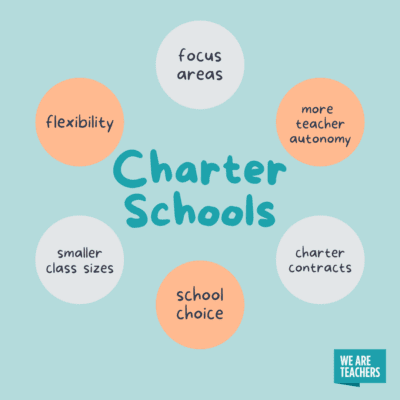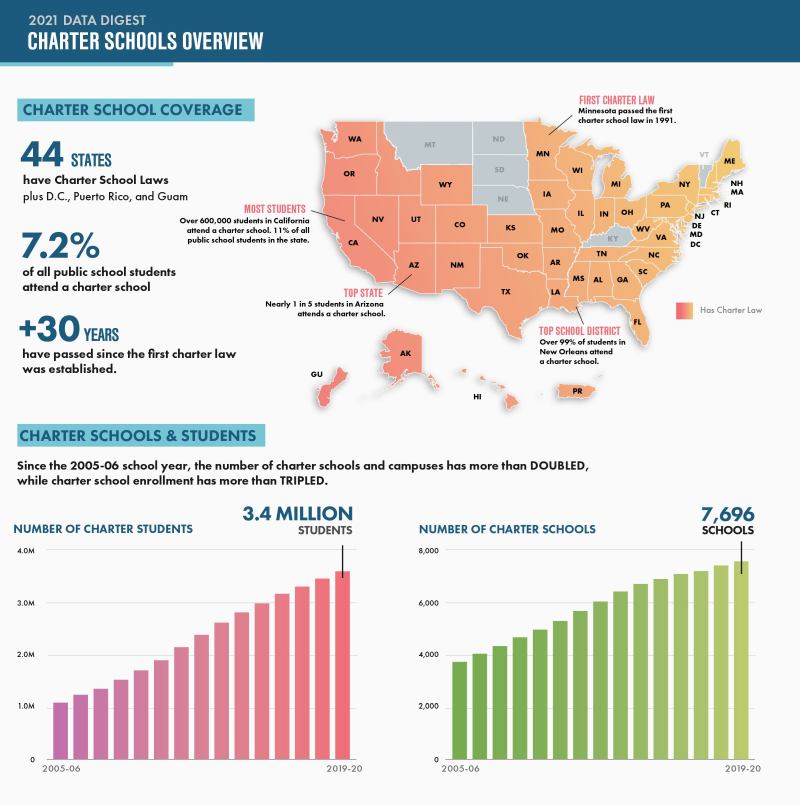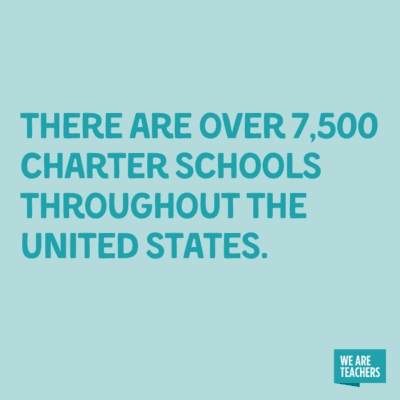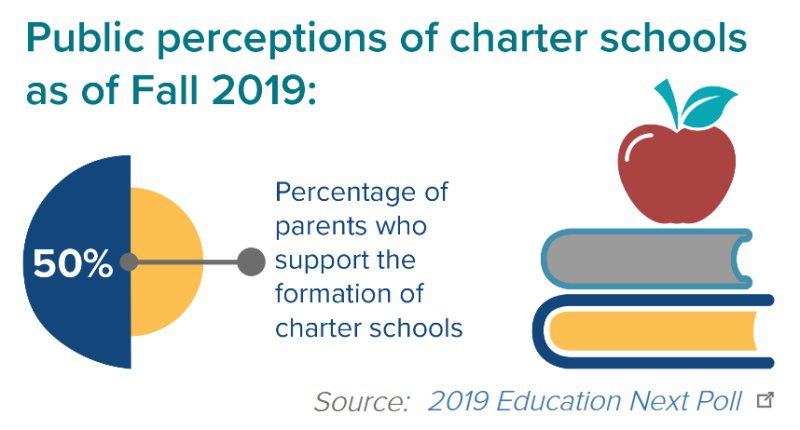For years, students in the United States either attended their local public school, a private school, or were homeschooled. These days, though, students and families often have more choices. One option that gets a lot of buzz these days is charter schools. Many parents and teachers want to know what charter schools are and how they are different from traditional public schools. Are they better or worse for students and teachers? These are big questions, and the answers are complex. Here’s a basic overview to get you started.
What are charter schools?

Charter schools are tuition-free schools that are independently run but publicly funded. Advocates call them “schools of choice.” Rather than being bound by state education laws, these schools create their own contracts (known as “charters”). These charters establish a school’s learning goals, mission, financial guidelines, and more. Each charter school has its own set of governing rules, which may or may not align with a state’s educational guidelines.
The 1970s saw a push for greater independence in education, attempting to provide teachers and schools the ability to create innovative solutions to their individual challenges. In 1971, UC Berkeley professors outlined proposed changes in a paper called “Family Choice in Education.” Ray Budde coined the term “charter school” in 1974, but the first charter school in the United States, City Academy in St. Paul, Minnesota, didn’t open until 1992.
Charter School Funding and Oversight
Like other public schools, charter schools receive funding based on enrollment. Each state funds their public schools differently, with formulas that consider a variety of factors. Sixty-one percent of states use the same formula for charters as they do for traditional public schools. Others limit or expand these schools’ access to local, state, or federal funding.
In most states, charter schools are subject to oversight by an “authorizer,” which is responsible for ensuring the schools meet their charter goals. These authorizers could be a state agency, a school district, a college or university, or other organization. If the authorizers determine a charter school is not meeting its stated goals, they can choose to shut down a school.
Many charters are part of a nonprofit charter management organization (CMO) network, like KIPP. Though the schools themselves are nonprofit, in some states they may be run by for-profit companies, called education management organizations (EMO). They may also work with for-profit management companies to hire teachers, provide and care for buildings, and more.
Who attends charter schools?

Source: National Alliance for Public Charter Schools
The percentage of public school students who attended public charter schools increased by an overall 1.7 million students between 2009 and 2018. They serve a higher percentage of students from lower socioeconomic backgrounds, and there are more of them in urban areas than rural ones.
Many families can choose to send their child to a charter school instead of their district’s public schools. However, some charter schools are so popular that they have caps on enrollment. In these cases, schools usually hold a lottery to select students to fill open seats, and some have application processes.
Types of Charter Schools
A 2015 report found that there are two basic types of charter schools, general and specialized. General schools look more like traditional public schools, but teachers usually have more freedom to try different curricula or educational approaches.
Specialized schools come in a variety of types (13, according to the report). These may be academic specializations, like STEM, humanities, or performing arts; or they may offer multilingual or single-gender environments. Others focus on behavior, including “progressive” and “no-excuses” schools.
How do charter schools compare with traditional public schools?

Charter schools are public schools, and they share some similarities with traditional institutions. But there are some major differences to understand too.
Both charter schools and traditional public schools:
- Are publicly funded and tuition-free.
- Offer at least 180 days of instruction per school year.
- Must administer state-required standardized testing.
But unlike traditional public schools, charter schools:
- Operate outside of a school district and are privately run.
- Can choose their own curricula, academic focus, and educational and behavioral models.
- Are able to accept students from outside traditional district boundaries.
- Can be shut down if they do not meet their stated goals.
Are charter schools effective?
This is a huge question, one that gets a lot of attention. After all, these schools receive public funding but aren’t required to follow the same rules as traditional public schools. Many worry that ineffective charter schools take money away from struggling traditional schools that need every penny they can get. So what do the experts say?
It’s important to remember that this type of school is still relatively new in the educational world—they’ve only been in existence for 30 years and have slowly gained traction over time. They also vary widely between districts and states, making it hard to study them consistently.
In 2013, a national CREDO study found charter schools were improving in performance. In 2009, charters lagged behind regular public schools in many metrics. But by 2013, they were slightly outperforming district schools. Interestingly, another CREDO study in 2017 found that charters run by for-profit companies were significantly less effective than those run by nonprofits.
Ultimately, each charter school stands on its own. Parents, students, and prospective teachers should look closely at the schools they’re considering. Ask to see measurable metrics based on goals that matter to you, and consider them when making a decision.
Charter School Pros and Cons
It’s very hard to generalize pros and cons, since each school is so different. Remember that those listed here may not apply in every situation.
Pros:
- Smaller class sizes (usually).
- Greater flexibility in curriculum and teaching style.
- Stronger ability and willingness to accommodate various learning styles.
- Focus on subjects that matter to students enrolled.
- Less concern about state standards and requirements.
- Some studies indicate minority students have more success at charter schools than public schools.
Cons:
- Since not always required to follow state standards, some charters have lower academic achievement in certain subjects.
- May offer fewer sports, clubs, and other extra-curriculars.
- Depending on the location, may not offer free transportation to and from school.
- If the school is under-performing or the organization running it struggles, it may be shut down, even in the middle of the year.
- The requirements for opening a charter school vary from state to state, leading to inconsistencies in quality.
What is it like to teach in a charter school?

Source: National Charter School Resource Center
Most charter school teacher positions require the same certification as traditional public schools. But there are a lot of differences in being a charter school teacher, and it’s definitely not a job for everyone. Read our full comparison of teaching in charter schools vs. traditional public schools here.
Here are a few general differences about teaching in a charter school.
- Charter school teachers generally have much greater flexibility in what they teach and how they teach it. This is a big draw for a lot of teachers.
- Charter school teacher pay is slightly higher on average, but many teachers report working even longer hours and more days.
- In general, class sizes are smaller at charters, though this can vary.
- Many charters do not allow teacher unions.
- Charters often opt out of state pension programs, instead setting up their own retirement plans. These may be better or worse than state pension programs, depending on the school and your personal needs.
What Charter School Teachers Say
Members of the WeAreTeachers HELPLINE regularly discuss the ups and downs of teaching at charter schools. Here’s what some of them have to say:
- “I taught for six years in a public high school in Austin, TX; I also taught for about 2 1/2 years in charter, and am currently in a charter. I find at least at the high school level that I have a little more freedom with my curriculum, but I’m one of only two English teachers (as opposed to the department of 20+ that I had in the public school). My class sizes are smaller at my charter school. My admin is much more involved with planning and student interactions at my current school. My pay is less than what I would get at the public school, but it’s not terrible.”
- “I worked for a CSUSA school. It was terrible. But 10 years with a city-sponsored charter was great. Our pay is a little less than the district, but health insurance is much cheaper. I have great students with invested parents. And I think that we have a lot more flexibility.”
- “Not all charters are the same. I have worked at a charter school for the last 23 years that has a union and competitive pay. Our school is pretty much like any of the public schools in the area except that we have a cap on enrollment so we have manageable class sizes. And we pay into the state retirement system as well.”
- “I worked at a public charter school and it definitely is not a place that I miss. The school was controlling towards students and teachers and micromanaged to a tee. What I noticed was that the majority of people who worked at the charter school didn’t meet the requirements to get their teaching license, so they were there. The health insurance was expensive and pitiful, the pay was a ripoff and full of deductions, and the behavior was horrible. I also know that this school has a high turnover rate with teachers … I quit that job so quick and went back to the district.”
- “I’m familiar with a few charter schools in my home state of AZ that have excellent reputations and have been around for years. Do your research if you want to consider teaching for one. If they’re new or not well recommended, teaching in one is a real risk.”
Charter School Information Resources
There’s a lot to know about these unique schools. Visit the following sites for more detailed information.




















